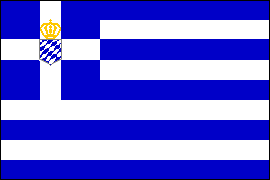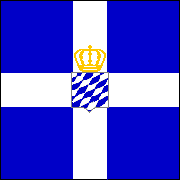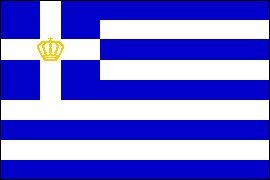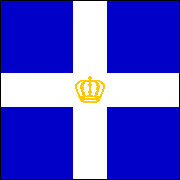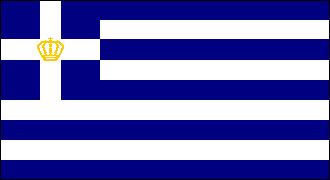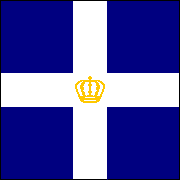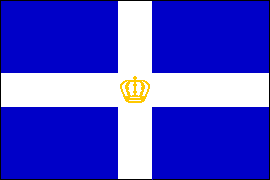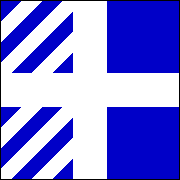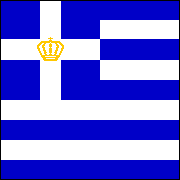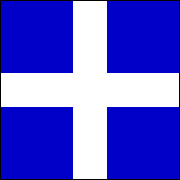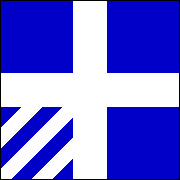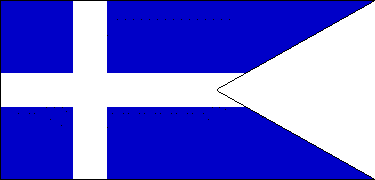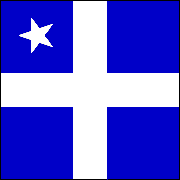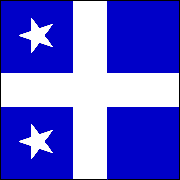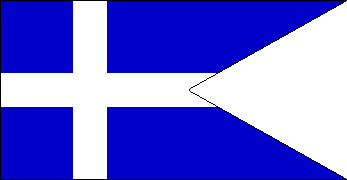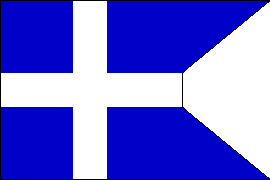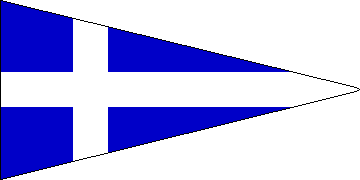KINGDOM OF GREECE
MILITARY & NAVAL FLAGS • 1833-1973
For most of the period between 1822 and 1973, when the monarchy was abolished by a military junta, Greece had two national flags: the plain cross flag and the cross-and-stripes flag. Generally though not at all times the former was used on land within Greece and the latter was used at sea and overseas. Blue and white are the Greek national colors, the cross is a symbol of Orthodox Christianity, and the nine stripes of the cross-and-stripes flag are said to correspond to the nine syllables of the war cry in the struggle for independence from Turkey: Freedom or Death.
The Kingdom of Greece used both flags, with the war flag, war ensign and naval jack being distinguished by the addition of a royal crown at the intersection of the cross. From 1833 to 1862, the crown ensigned the arms of the Bavarian dynasty that supplied Greece with its first monarch. With the accession of the Danish dynasty in 1862, a crown alone was displayed. The air force flag had the crown in the first quarter with the blue-white-blue Greek roundel at the intersection of the cross. The commissioning pennant was similar to that used nowadays by the Hellenic Republic, but longer and narrower. When flown from the main or principal mast of a Greek warship the jack denoted the presence aboard of the King or a member of the royal family.
Between 1926 and 1935 Greece was a republic and the royal crown was removed from all flags.
At the beginning of the twentieth century the rank flags for admirals and vice-admirals had diagonal blue and white stripes in the hoist quarters; later these were changed to white stars. From that point forward the diagonal stripes were used to distinguish the flags of various government ministers. An exception was the flag of the Minister of Marine, which was a square version of the naval ensign. The flags for admirals followed British practice: a plain cross for admirals, with one and two stars being added for vice-admirals and rear-admirals respectively. The broad pennants for captains commanding (later commodores) and the squadron commander's pennant bore a certain resemblance to the Danish naval ensign, possibly because the Greek royal house was Danish in origin.
The plain cross flag and its variants were abolished in 1970. The crowns were again removed from all flags in 1973 when the monarchy was abolished, but otherwise Greek flags did not greatly change.
Flag Proportions: The Greek national flag and its variants have generally been made in 2:3 proportions. An exception was the cross-and-stripes flag and ensign of 1970-78, for which 7:12 proportions were specified.
Color Shades: Traditionally, a shade of light blue (somewhat darker than sky blue) has been employed for Greek national flags. In 1970, however, a much darker blue began to be used, as illustrated below for the 1970-73 naval ensign and jack. The light blue shade was restored when a new flag law was passed in 1978, though the law does not specify an exact color shade.
Images Added January 2016
Naval Rank Flags & Command Pennants • First Pattern
